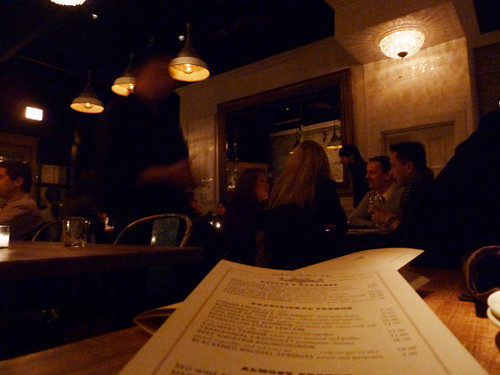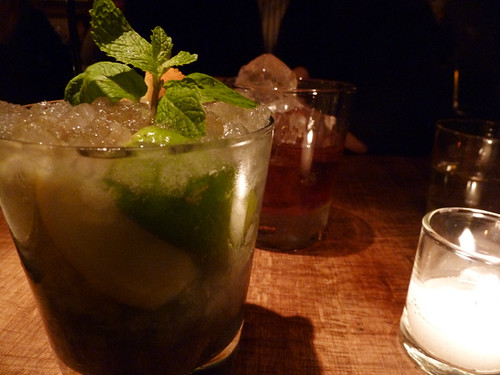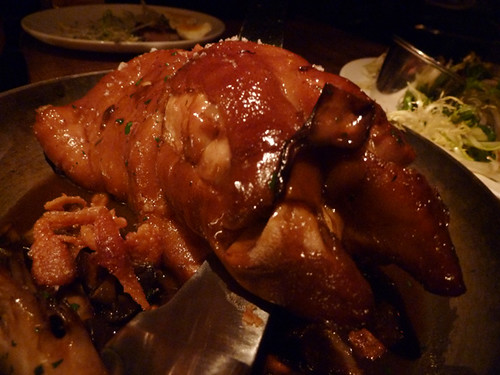
(Can I really be the first person to use that headline in regards to Maude’s Liquor Bar? Where has our educational system failed?)
When I interviewed Jared Van Camp of Old Town Social last summer for my week’s stint at Grub Street, he mentioned that a number of restaurant groups had a French-flavored place in the planning stages. I’m not sure which he was necessarily referring to but suddenly we have buzz about three of them— Maude’s Liquor Bar, Paris Club (the revamping of Brasserie Jo), and Grant Achatz doing fin-de-siecle Paris as the first concept at Next. (You could probably add the Belgian Leopold as close enough, too.) It’s not hard to understand why French food would be the next place to turn for small-plates eating and drinking concepts— if any cuisine is ready to be liberated from stuffy fine dining practices, it’s French. So Maude’s, under Chef Jeff Pikus (an Alinea alum, not that there’s much sign of that on Maude’s menu) presents us with French food refracted through the American gastropub trend, with lots of emphasis on cocktails and pork— neither, of course, out of character for Gallic dining. The result, though, seemed more successful the closer it hewed to classic French food, and the less so the closer it got to greasy, porky American gastropub food.
I will say that I was charmed by the room, the moreso as I was slightly expecting to find it too cool for school. It’s as dark as Girl & The Goat across the street, but where that seems cavernous, this was intimate and a little funky, white tiles around the bar, a thrift-shop mismatch of lighting fixtures and eclectic comfy seating. The effect is not so much of a literal evocation of France as of later caricatures of the fin-de-siecle period; it’s a little like being inside the curlicues and squiggles of a drawing by Ronald Searle.

There’s a drink menu of wines, beers and liquors by brand name, but you probably want to hunt out the cocktail list on the back of the food menu. There’s a short list of classic cocktails and then their own collection of “smashes,” drinks muddled much like a mint julep, though the fact that they don’t actually tell you anything beyond the names makes these something of a crapshoot. But someone had liked the Smokey Violet, which I ordered to find that it was neither smokey nor violet but, indeed, green and minty as a julep. (I wouldn’t rule out the possibility that I was given the wrong drink, but since no precise description of the drinks exist, it’s impossible to know for sure.) Kristina Meyer in The Reader said the drinks all tended toward the sweet side, and that was the case here, but I thought it (whatever it was) was a complex and highly refreshing drink. What might be of more concern, though, is that it didn’t seem very alcoholic. Not that I’m looking for a particularly stiff belt, but in February, I’m not exactly looking for the sort of mild, summery drink that goes with sitting on the open-air patio and knocking back five of them with little effect, either.
There was a special of a trotter (pig’s foot) stuffed with sweetbreads and mushrooms, so we ordered that and a cassoulet; brussel sprouts and frites as sides; and a lyonnaise salad. First let me praise the best things; the frites, fried in an oil mixture including pork lard, were terrific, and the brussels sprouts, quite huge by the way, were served in a meaty broth which accented their bitter char, and were excellent.

The lyonnaise salad was, I thought, fairly good. All frisee, it reminded me of the director Lawrence Kasdan’s long-ago comment that eating sprouts was like going down on an alien. But the flavor of the tart bacon dressing on the greens was very well balanced. I’m not sure it was an improvement to serve the lardons as three whole slabs of grilled pork belly, and it definitely wasn’t one to serve an allegedly soft-boiled egg on top which had barely any liquid left in its center. This wasn’t a bad version of a classic dish, but it was one that fixed parts of it that weren’t broken.
The cassoulet… we were divided at our table over this. My companion thought it was a bad cassoulet, I thought it was a pretty good bean dish saddled with a name that promised too much. Cassoulet seems to be a problem for restaurants; nobody wants to do it the hard, two-day way, so they come up with various methods for cooking the parts separately. (My friend Kennyz, for one, prefers this, since the beans aren’t turned to mush in the process.) I’ve had some where the flavors melded beautifully (The Southern) and some where the ingredients seem to have met each other for the first time on my plate seconds earlier (Hot Chocolate, long ago) and some where the meats seemed kind of separate but had so much robust individual flavor it hardly mattered (Leopold a couple of weeks ago). As cassoulets go, this one was pretty good navy bean soup, by which I mean, the beans and the pork (shank, to judge by the look and the gelatiney shimmer) had melded together beautifully, but the dish stopped there, halfway to the variety of tastes and textures that is cassoulet to me. Next to Leopold’s, which had a robust sausage and a savory hunk of rabbit (understudying for duck), this was just ham and beans. (Note: Since Heather Shouse refers to the cassoulet as “sausage-studded,” it must change regularly, as ours was most certainly sausage-impotent.)

And then there was the trotter, which had been praised by some at LTHForum but was, for both of us, a disaster. Below the shank there’s virtually no meat on a pig’s foot; it’s all gelatine. So stuff the skin with sweetbreads and all you’ve created is a turducken-like monstrosity which functions as a delivery system for vast amounts of greasiness, sealed in by the skin. And even if that were appetizing, there was something bitter and antagonistic about the broth that the sweetbreads and the chunks of hen of the woods mushroom were swimming in, that made it hard to even nibble on the parts. This seemed to be filling a American gastropub slot for porcine excess that was certainly alien to the way pork is eaten in in France— except perhaps in the kind of overblown, Bocuse d’Or-ian stunt cooking where you sculpt some dead creature into an unnatural shape, and how it tastes is largely irrelevant.
One problem, that may not have been fatal to the trotter but surely didn’t help, was that it came at the very end. I’m about ready to rebel against the whole way small plates are being served in this town, the “order everything at the beginning and we’ll bring it to you as it’s ready” way of doing things, because I think chefs are shooting themselves in the foot for the sake of logistical convenience. The order of our dishes was the fries first (so they accompanied nothing and filled us up quickly), the brussel sprouts (likewise a side dish without a main), the cassoulet, the salad (at least that had some resemblance to the French practice of eating salad after the entree)— and then the grease bomb. Almost none of this was in an order that made for a satisfying flow of dishes; we started out snacking on fries like teenagers and ended stuffing ourselves with entire pig parts like Mr. Creosote. (Or would have, if we’d finished much of it.)
At the end of it my dining companion said that if he returned, he would stick to something straightforward like steak and frites, and probably be happy; the kitchen did a mostly fine job on the things that were simple like the brussels sprouts (really, one of the best vegetable dishes I’ve had in a while, and calling it simple is not meant to damn it with faint praise), but was led astray by attempts at modern gastropubbby reinterpretations like the trotter, which were just too much and too off-kilter in conception. For all that, and despite the pain of the most expensive dish being the biggest flop, I liked Maude’s overall, a little sophisticated, a little comfy, a little decadent, a lot porky (for better and worse), and having some sense of its strengths and flaws, I’d order accordingly next time— and hope that the kitchen, surely reeling from being slammed as the hot new place of the moment, will follow its strengths over time, as well.


 If you like this post and would like to receive updates from this blog, please subscribe our feed.
If you like this post and would like to receive updates from this blog, please subscribe our feed.




